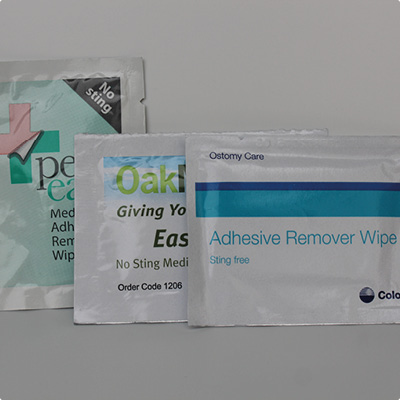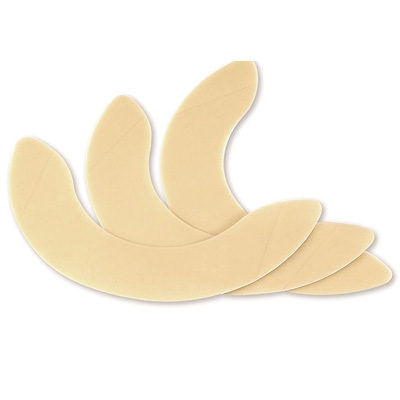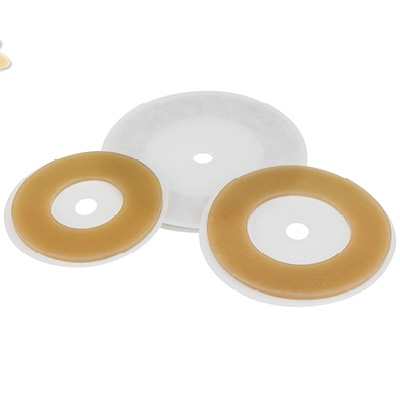If your stoma causes you problems, such as leakage or sore skin, there are many accessories available to help out. However, the range of accessories has become so wide that it can be confusing to choose what is right for you.
How many to use
In stoma care, it is usually best to follow Coco Chanel’s mantra that ‘less is more’. The first thing to ask is whether you are using the best appliance for your stoma and the surrounding skin—something as simple as switching to convex flange could resolve the issue. Only use convexity after speaking to your stoma nurse.
When it comes to accessories, some people don’t need to use any at all, while others may need two or three. It is usually a good idea to supplement the warm water, disposal bag and dry wipes, cloth or kitchen roll used in regular pouch changes with adhesive remover spray. If you continue to have regular leaks or sore skin, or you need extra support in a particular area, it is worth looking at adding accessories to your routine. You should always seek the advice of your stoma care nurse before trying a new accessory, to avoid the risk of accidentally doing more harm than good. For example, chemicals in certain sprays or wipes can cause a reaction in some delicate skin.
Who's paying?
Ostomates in the UK are lucky enough to have the NHS cover the cost of stoma accessories. However, the NHS has to make every penny count, and these accessories are expensive. For example, a can of adhesive remover spray will likely cost over £7, so excessive or unnecessary product use can be a significant drain on the health service. Your GP may ask you to switch to a cheaper brand of an accessory, or to review whether all the products on your order are still necessary. Be aware that, as GP surgeries are becoming more budget-conscious, some are having to restrict their accessory formularies and may replace certain products with a more cost-effective option.
Daily care
Adhesive remover
Adhesive removers help you remove a pouch without damaging the skin. They come as either a spray or a wipe, you should only need to use one form.
Remover spray should be applied in small amounts around the edge of the flange and allowed a few seconds to work on loosening the adhesive around the edge. You can then carefully peel the pouch away from your body and spray another small amount on either side of the stoma to help the pouch come completely away, while using your finger to push the skin away from the adhesive flange as necessary. If you find your skin still feels sticky with adhesive, you can spray some of the remover onto a dry wipe and gently rub the affected area.
For those who prefer a wipe to a spray, gently rub the wipe around the edge of the adhesive and keep rubbing the wipe as you remove the pouch from your skin.
Skin cleansers
Plain old water is usually sufficient for cleaning around a stoma. Indeed, you can clean this area when bathing or showering without a pouch, although the stoma may function in this time. Shower gel or bubble bath can be used, although those containing oil should be avoided, as they may leave a greasy residue on the skin that makes it harder to form a seal.
In some situations, you may prefer to clean the skin using specialist skin cleansers. These come as lotions or sachets of wipes. Some companies provide free samples, and these are especially handy when out or in an emergency, as they can be kept in a pocket or small bag.
You may find that a pack of ordinary wet wipes does the job just as well. These can be purchased quite cheaply from supermarkets, but do avoid those containing alcohol or fragrance.
Forming a seal
 Adhesive paste
Adhesive paste
Adhesive paste is used to fill small dips or creases in the skin to create a better seal. It is usually sufficient to place a pea-size blob in the problematic area (most commonly at the 3 and 9 o’clock position on either side of the stoma). If you need paste all the way around the stoma, you may be better using a seal. If you have a wound or fistula, a nurse may show you how to use adhesive paste to create a barrier around the area. Use a dab of water when levelling it out. Adhesive paste is not to be used as glue to stick the pouch to your skin.
Seals
Stoma seals, also known as washers, rings or donuts, are also used to fill in a dips or creases in the skin, but, compared with paste, they can give a more uniformly flat base for the pouch to stick to. They form an effective barrier for particularly moist or wet stomas, so urostomy patients often find the addition of a seal helps the pouch last for 2 days, saving the need for daily changes. Flexible seals are available that can be stretched around the stoma.
Seals may need to be cut to fit with scissors. It is not always necessary to use the whole ring, and some people might find them more useful cut into half smile-shapes. Seals are also useful to cover areas with granulomas (a skin complication).
 Flange extenders
Flange extenders
Flange extenders, also known as bananas, half-moons, horse shoes and security frames, are extra pieces of flange material (hydrocolloid or silicone). These are used to help secure the pouch to a particularly problematic area of skin where it has been lifting away. Depending on your body shape, this could, for example, be a crease next to the tummy button. They are often used at the 12 or 6 o’clock position of the flange.
A flange extender is sometimes used all around the pouch to provide extra security. However, if the pouch is only staying on with the help of an extender, it is quite probable you need an alternative pouch. Although flange extenders are very useful in certain situations, your pouch should stick well without their help. If you are having regular leaks, it is best to address the cause of the problem rather than patching it up with flange extenders. If you find yourself doing this, do speak to your stoma care nurse.
Protecting the skin
 Barrier products
Barrier products
Barrier products form a film that protects damaged skin from the stoma output. If the skin around your stoma is healthy and intact, you will not need these products. However, if the skin appears red or pink and feels sore, this may be a sensible option, and you should consult your stoma care nurse for advice. To ensure a good seal, carefully clean and dry the skin before applying a barrier, and wait for a glossy tinge to form before fitting the pouch.
Barrier products are available as a spray, wipe or cream, although you should only need to use one type. Barrier wipes are easy to use, but shouldn’t be used as a cleanser. Barrier creams can be greasy and should only be used in very small amounts, otherwise the pouch won’t stick to your skin. If using a barrier spray, make sure not to mix it up with an adhesive remover spray, as you will find your pouch won’t stick properly if you use the wrong one!
Stoma powder
If the skin around the stoma is wet and sore, your stoma care nurse may provide you with stoma powder. Your nurse will be happy to advise you on its use. Be careful not to use too much; just a thin sprinkle on the affected area is sufficient. Make sure to dust off the excess powder when applying. If stoma powder is needed in the long term, it is also available on prescription.
It is also useful if you develop a mucocutaneous separation, which is when a gap appears between the skin and the edge of the stoma. This is usually a temporary issue that quickly heals.

Modifying the output
Bulking agents
Bulking agents, also known as stool thickeners, change the consistency of a stoma’s output, making it much thicker. They can be useful for people with a colostomy or ileostomy that is producing a high output or a very loose watery stool. This is particularly useful during the night for people who struggle with leaks in the bed, However, bulking agents are not suitable for urostomies, as they pass urine.
Bulking agents come as sachets, capsules or teabag-style packs. Whatever form they come in, they should be inserted into the pouch before applying it to the skin, or in the pouch’s outlet after it has been emptied. Bulking agents should never be taken orally. If for any reason you need to measure your output, do it before you use a stool thickener, to ensure an accurate measurement.
Deodorants
A stoma’s output typically has an unpleasant odour, although a good seal should prevent it from escaping the pouch. If you are concern about odour escaping, deodorants of different fragrances are available, either drops that are added to the pouch or as sprays for use in the area where a pouch has been emptied the pouch.
Deodorants are very expensive, and some GPs will not routinely prescribe them. Instead of USING a deodorant drop, some people place a Tic Tac sweet into their pouch to avoid odour. A similar affect to the spray can be achieved using ordinary room fragrances, available as diffusers, plug-ins or air-freshener sprays. Some people strike a match or light a candle after changing. A perfume sample bottle or travel deodorant spray can be kept in a pocket or small bag for when you have to empty your pouch outside your own home.
Preventing or supporting a hernia
Support garments
One of the most common complications of stoma surgery is a parastomal hernia, when a part the intestine protrudes through the gap in the abdominal muscle created for the stoma. Luckily, you can reduce your chances of getting a hernia by doing exercises to strengthen the muscles and wearing garments that support your abdomen. All ostomates are recommended to wear a support garment if they are undertaking tasks that involve lifting or heavy work, such as gardening, decorating or sport. People who have already developed a hernia should also wear a support garment to prevent the hernia from getting any bigger.
Support garments come in the form of underpants or belts, and your stoma care nurses may arrange for you to have two or three pairs of on discharge home from hospital. These should be replaced yearly. They can be ordered bespoke or readymade from the website of one of many companies that specialise in making stoma support wear.
You can also purchase these on your own or put them on your prescription. Some companies offer a measuring service, which is particularly useful for people with large hernias or who do not find regular sizes to be suitable. Speak to your stoma nurse if you are concerned about a hernia or need advice about which garment may be the best type for you.
References
Black P. Holistic stoma care. London: Balliere Tindall; 2000
Burch J. Stoma care. Hoboken, NJ: Wiley; 2008
Burch J. Pre and post op care for patients with a stoma. Br J Nurs. 2015;14(6): 31–8
Conclusion
A good understanding of the different accessories available and the reasons why they are used will allow you to respond to any problems when they occur. You can pick up samples at events for ostomates, including company open days or coffee mornings. However, you should make sure that you seek professional advice before using them, as you may not require whatever you have been offered. Don’t be afraid to ask if a product might be useful for you, but remember that less can be more.

Lisa Hall is a Community Stoma Care Nurse at Salts Healthcare
The contents of this page are property of MA Healthcare and should not be reused without permission


